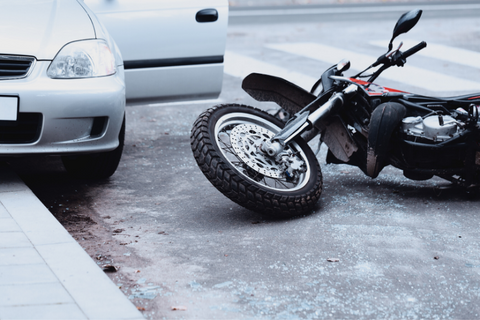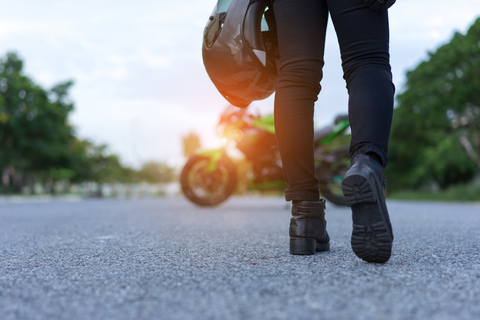
May is Motorcycle Safety Month.
Even if you've been riding since you were in diapers, part of riding is constantly evolving and refining your skills. We are bringing back some of our previous posts about motorcycle safety all month.
-----------
The scene: a Bell Helicopter dealership in Any Suburb, USA...
A customer walks up to the salesman and points at a shiny new Bell 505 Jet Ranger. “How much is this one?” he asks.
“This baby?” says the salesperson, caressing the shiny painted metal of the door. “It’s $1.45 million, but there’s a manager’s special this weekend only; $1,000 off if you buy today!”
Twenty minutes later, paperwork signed, the chopper is out in the parking lot, the 377 kW turbofan motor shrieking to life as the blades slowly begin to turn. The new customer is sitting in the pilot’s seat as the salesperson yells at him through the open window.
“You know how to fly this, right?”
“Sure! I watched lots of YouTube videos!” comes the reply, accompanied by an enthusiastic thumbs up. The salesperson steps aside, grins, waves and then saunters back into the dealership: another satisfied customer.
Luckily, this never happened. But it does happen with motorcycles. A well-heeled customer can indeed walk into a motorcycle dealership, buy a motorcycle that rivals a Bell 505 in power-to-weight ratio, acceleration and top speed, and ride it home (if they make it home) without any proof of training or even a license in most US states. Seriously.
Most US riders are self-taught or have only taken a very basic 15-hour licensing course. That may be you. But just because you can ride a motorcycle with minimal or no training doesn’t mean you should ride a motorcycle with minimal or no training. And once you’ve had some training, it doesn’t mean you’re done with training forever.
We want you to know why you need training, what kind of training you need, the types of formal and informal training available and how to be a life-long learner.
What Kind of Training Do You Need?
Motorcycles are cool because they’re dangerous. Compared to other sorts of motorized (ground) transportation, they’re fast, very complex to operate, behave in tricky ways in emergencies and offer no protection to the operator and passenger. That’s why motorcyclists die in crashes at 27 times the rate of other vehicle drivers (per vehicle mile travelled, or VMT), and 95% of reported motorcycle accidents result in some form of injury, according to the Hurt Report, a 1980 study of 900 motorcycle crashes.
One thing the Hurt report noted was riders reporting some kind of formal training were underrepresented in the crash data. The report states “…92% were self-taught or learned from family or friends,” and goes on to say that “rider training experience reduces accident involvement and is related to reduced injuries.”
That’s because good training does several things. First, it makes you understand motorcycles are dangerous. It also shows the student the attitude a rider needs to not crash, and of course it teaches the skills and strategies needed to operate a motorcycle.
But what kind of training do you need? Well, that depends on your skill level. The most popular courses in the US, by a very wide margin, are the basic safety classes offered (and frequently required) by state governments. These teach basic skills and provide a simple, convenient way to get a motorcycle license.
There are also intermediate-level courses that teach more advanced, street-based skills. These can be through private organizations or through state-sponsored programs, and there are also independent coaches who can give private lessons one-on-one or to small groups.
Off-road courses also offer skills that translate (maybe surprisingly) into street-survival skills. “Motorcycle riders with dirt bike experience are significantly underrepresented in the accident data,” the Hurt report states. For more advanced riders, there are closed-course trackday instructional events and competition schools. These courses teach techniques ranging from intermediate to extremely advanced – imagine a controlled two-wheel drift in a 70-mph corner and you’ll know what that means – although the effect on motorcycle safety is complex.
Let’s check out some of these training opportunities in depth.
State Licensing Programs
State licensing courses can be controversial, which is surprising. If Hurt found trained riders are less likely to crash (and be injured as a result), some training, even the most basic, is better than none, right? Well, yes and no.
On the yes side, even though, 40 years after the Hurt report and 30+ years after basic rider education became a staple through the Motorcycle Safety Foundation, further studies have found little or only mild evidence rider training decreases crash and fatality rates. “Research to date has not consistently supported the notion that training is either effective or ineffective,” concluded a 2009 review of motorcycle-training studies.
Still, the benefits we mentioned above can only be described as positive, regardless of what studies show. They can’t, no pun intended, hurt.
In the last couple of decades, alternatives have emerged. Oregon and Idaho has a native-grown approach to its state-sponsored training and licensing. California is the largest single market for motorcycles in the US and adopted the Total Control Training, managed through the California Motorcycle Safety Program.
Spurred by requests from the California Highway Patrol, which oversees motorcycle training for the state, Total Control’s’ approach is different from the prior program in two important ways: it seeks to fully inform riders of the dangers of motorcycling by telling students exactly how much more dangerous motorcycles are than cars, and it provides a more rigorous range experience. Students get approximately twice the actual riding time and a significantly harder-to-pass skills test at the end.
If your state only offers the MSF Basic RiderCourse, have no fear: we’ve taught both MSF and CMSP (which is partly based on Oregon and Idaho’s alternative program) and both programs offer benefits to new riders, are fun to take, and really teach you how to ride. But neither should be regarded as the alpha and omega of your learning experience! They are only the first real step.
Advanced Street-Training Courses
Unfortunately, that second step may be harder to take. The MSF, through its partnered privately owned schools, offers some advanced street-riding courses but they are not offered in all parts of the country or at all times of the year (if at all), and few private entrepreneurs have started their own riding schools.
The problem isn’t supply: it’s demand. Even when courses are offered, only a small percentage of riders seek training opportunities beyond the basic classes, discouraging new courses from being offered.
One exception is Total Control Training’s series of riding clinics. Offered all around the United States, students can choose from Intermediate, Advanced, Advanced Level 2 and even closed-circuit racetrack instruction. Founder Lee Parks set up his classes to teach fundamental, fact-based riding skills in controlled, safe environments, and each course builds on skills learned in prior ones. These courses are not basic or licensing courses at all.
Another option is private motorcycle coaching. There may be a few independent operators in your area, and working with these folks is usually a good experience. Not because they’re motorcycle safety geniuses, or have some special approach. Because one frequent cause of new-rider crashes is unfamiliarity with controls, motorcycle dynamics and braking, just practicing under a tutor’s watchful eye is something that can’t hurt.
Some examples are Monkey Moto school in San Francisco, or Ride 2 Ride Again in Los Angeles, but there is probably someone in your area; just do a web search for “private motorcycle classes.” This kind of training is great if you have a tight schedule or need more attention than the average student, but doesn’t get you the license-test waiver like the MSF and CMSP programs.
Trackdays and Competition Schools
If riding a motorcycle on the street while (mostly) obeying all traffic rules is fun, riding on the racetrack where the only limits are yours, the motorcycle’s and the laws of physics is…sublime. But does it make you safer?
That depends on who you ask. Racers will tell you their heightened reflexes and superhuman skills saved their bacon many times on street rides, while cooler heads might observe that those keeping the speeds down likely will never need such skills in the first place.
Plenty of very experienced riders and racers are injured or killed in street crashes. In the words of one safety professional (who prefers to stay anonymous), “racetrack skills seem to just increase the speed you’re going before you crash.”
Still, doing a trackday on your street motorcycle is an invaluable experience. Not just because it’s fun, but because it can give you confidence in your own abilities, as well as the motorcycle’s. You’ll be amazed at how far it can lean over, how fast it can go and how quickly it can change directions, but you’ll be even more amazed at how dang slow everybody else seems to go when you take your first street ride after a trackday. Slow down!
Trackday instruction is offered at just about any racetrack, but some of the established programs include Keith Code’s California Superbike School and the pricey-but-intensive Yamaha Champions Riding School. The school you pick will depend on your budget, location and skill level.
A good way to learn some of the skills and gain some of the confidence you’ll get at a trackday is to do an off-road riding school. The MSF offers both basic and trail-riding courses through local providers, but there are many private schools teaching at all levels, from basic skills for 3-5 year-olds to flat-track racing instruction to rigorous off-road adventure riding training, where students wrangle 600-pound, 120-horsepower behemoths through mud, water crossings and sand.
Literature and Other Media
Maybe the easiest and least-expensive way to learn is by exercising your brain. The amount of literature on motorcycle training is staggering, but there are a few must-reads we can recommend.
Proficient Motorcycling: The Ultimate Guide to Riding Well
Author David Hough is a well-known journalist and safety advocate, with 60 years of riding and writing experience. Using clear and entertaining writing, Hough lays out his tips and techniques for staying safe and enjoying the ride. Not only does he tell you how to do things like staying warm and dry on the bike, riding with passengers, packing for long trips and riding in groups, he also explains why you should follow his advice, with chapters on motorcycle dynamics and other basic principles. His follow-up books, including the Good Rider and Mastering the Ride are worth a read as well.
Total Control: High Performance Street Riding Techniques
We’ve mentioned Lee above, as he’s left a serious mark on motorcycle safety and training in this country, but he’s also a serious writer and journalist. His book is one of the best-selling riding-skills books ever published (bootleggers even published a Russian version without Parks’ permission) and no wonder; it’s richly illustrated and lays out clear, concise concepts and lessons (including instructions for setting up riding exercises on your own). It’s anything but dry, bureaucratic safety-blather, too. “Get it right, and a modern motorcycle will provide you with the thrill of a lifetime,” he writes. “Get it wrong and you'll be carted off in a meat wagon.” Plus the Kindle version is just $3 on Amazon; can you afford not to read it?
A Twist of the Wrist: The Motorcycle Road Racers Handbook
Although Keith Code’s book is aimed at racers, it still has something for street riders. Code has coached racers and novice track riders alike for decades (before that he made custom platform shoes in Hollywood, true story), and his observations and understanding of motorcycle and rider dynamics can help you understand how motorcycles turn, steer and stop. That understanding can mean the difference between crashing and not crashing in a bad situation, makes Twist of the Wrist (and its sequel, A Twist of the Wrist II) worth reading.
There are thousands of other titles, and there are also magazine and journal articles, as well as YouTube videos (please watch these with a critical and skeptical eye) and many other resources, but maybe the best training you can get is to be part of a well-connected rider community, whether it’s the American Motorcyclist Association, a local club, or just a Facebook group or online forum. Get enough riders together, and someone will have the answer, no matter what it is.
That’s a lot of training options, and there are likely many things we’ve left out. What skills you need are up to you, but sometimes the most valuable thing you’ll learn from being a life-long student of motorcycling is that you’ll never know it all, and you’ll never be the fastest, safest, smartest or best-looking rider in the world.
Like the ride itself, motorcycle education is a journey, not a destination. Ride safe!





